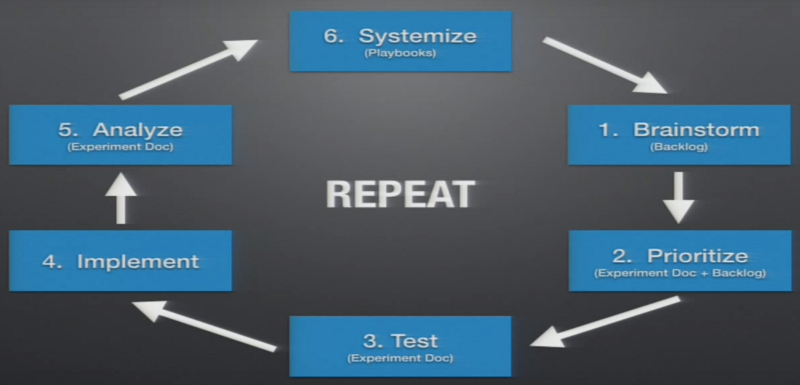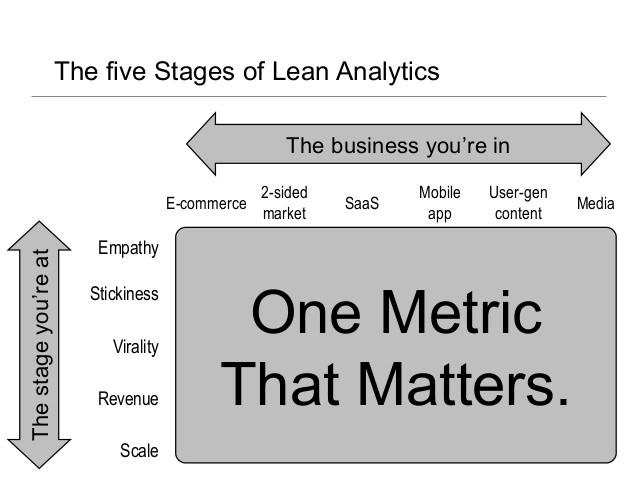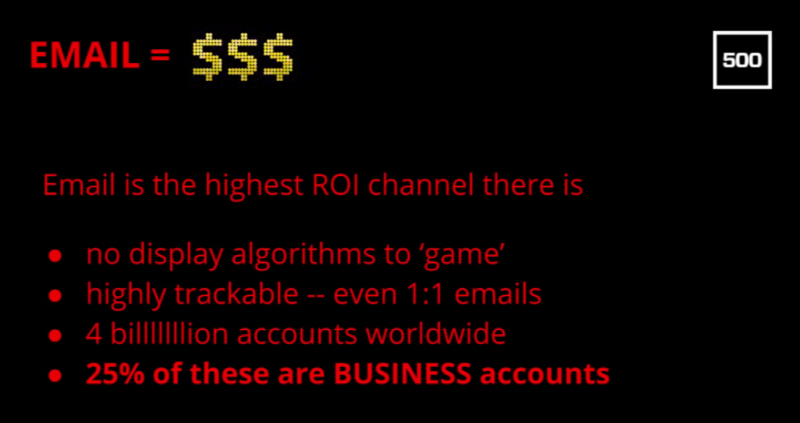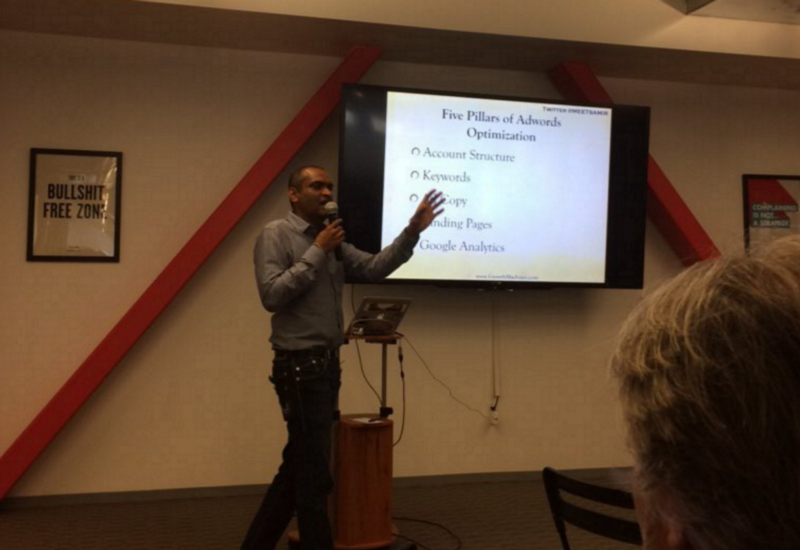In this week’s post 500 founder Troy Sultan shares his take on the ~25 hours of lectures, workshops and presentations by 500 growth mentors that we call Marketing Hell Week. The week’s programs cover everything from pricing and positioning to marketing metrics, content marketing, viral growth and more.

MHW did indeed live up to its name. There was far less time for “real” work, so a lot of us had to get creative. Taking calls and meetings during breaks or lunch, scheduling walking meetings to and from the office, and leaving the office at or past midnight were common themes for most of us.
This post is long, so I’ll get right to it.
Note: There were few sessions I didn’t attend which is reflected in the notes below. Also — huge thanks to Tammy, Susan and all else who helped make MHW so memorable (and exhausting).
DAY 1
Building A Growth Machine w/ Brian Balfour (video)
- Growth has nothing to do with tactics, everything to do with process
- Silver bullets don’t exist: what works for others won’t work for you
- Experiments don’t always have to be right, but theres an expectation that the results and learning improves over time
Goals of the process:
- Rhythm: Momentum is powerful. Establish a cadence to fight through failures, get to successes and find momentum.
- Learning: constant learning of your customer, product, channels, and feeding and learning into the process to improve.
- Autonomy: individuals decide what they work on to achieve the team goals.
- Accountability: with autonomy comes accountability. You don’t have to be right all the time but there is an expectation to improve.
Setting goals: OKRs (Objectives and Key Results)
- Objective: Qualitative statement (timeframe: 30–90 days)
- KR1: Measurable goal 1 (hit 90% of time) (relatively easy to hit)
- KR2: Measurable goal 1 (hit 50% of time) (pretty good job)
- KR3: Measurable goal 1 (hit 10% of time) (knocked these out of park. lets go to vegas and celebrate)
If you rarely hit KR1s, you’re being too aggressive. If you regularly hit KR3s, you’re not setting goals aggressively enough.
Process:
- Brainstorm
- Prioritize
- Test
- Implement
- Analyze
- Systemize
REPEAT: as many times as possible within 30–90 period of OKRs

4 key documents:
- Backlog: idea dump (everyone contributes). Provides an outlet to dump any ideas that arise as you go through the experimentation cycle (don’t keep them in your head).
- Pipeline: ledger of experiments that you’ve run previously, the ones currently running, and the ones on deck. When a new member joins your team, they’ll see every experiment you’ve run from day 1, understanding clearly how you got to today.
- Experiment doc: (most important) forces you to think through whyyou’re doing this experiment, what you expect to learn from it, how you’ll design and implement it successfully, and what learnings might help you improve.
- Playbooks: step by step guides to successfully repeat the things you want to do over and over again.
After a few cycles (quarterly or every ~4mo) look at:
- Batting average: how many successes to failures? Improving over time?
- Accuracy: are your hypotheses getting more accurate?
- Throughput: how many experiments are you running in a given time period? How do you do more?
Pricing and Positioning: Mat Johnson
Positioning: be IMPORTANT!
- For customers
- For word-of-mouth
- For investors
- For acquisitions
Pricing is NOT about revenue. It’s about:
- Strategy and competition
- Customer segments
Pricing could be a matter of life and death. You’re a small startup — if you don’t already have an unfair advantage, you’ve already lost.
Customer attention:
- Do I care enough to pay attention?
- Does this product address my #1 problem?
- Is this product even any good?
How to think about acquisition multiples:
- Revenue alone: 1x annual sales (“internet property”)
- Eng team: $1M/high-quality engineer (“acqui-hire”)
- Strategic Leadership team: $50M+ (Assistly/Desk.com)
- Market-winning product line: $1B (Yammer)
- Strategic threat/the future: $B+, 10% mkt Cap (Instagram, Whatsapp)
Summary:
- Compete with pricing
- 3x your revenue, just by asking for it
- Raise money at higher valuations from better investors by positioning yourself as the future
- Sell your company for higher multiple
One Metric That Matters (OMTM): Andrei Marinescu

Focus is major key advantage. A good metric is:
- Comparative
- Understandable (can the board members understand it?)
- Actionable
- A ratio (not an absolute value. e.g. # of users)
- An enabler of behavior change (does it let you know if things are going well or not?)
What are you trying to measure?
- Qualitative (e.g. customer sentiment) vs. Quantitative (LTV, CAC, etc…)
- Vanity (# of accounts, # of page views etc…) vs. Actionable (purchases)
Leading vs. Lagging:
- Leading = does it predict success? You can act upon it with these customers (customer satisfaction)
- Lagging = by the time you see it, you have already failed with these customers (churn)
Correlated (it correlates to certain events. e.g. more purchases on Sundays) vs. Casual
How to choose your OMTM: have context!
Type of business is important (B2B, B2C, SaaS, gaming, app): similar companies have similar OMTMs
Bad OMTMs:
- # of page views
- # of unique visitors
- # of downloads
- # of registrations
- # of shares / likes
- # of emails collected
- Time on site
The time interval for the OMTM should be weekly (something you can look and react upon every week).
Funnel-related OMTMs are good, because they will work for ANY acquisition channel.
Fireside Chat: Dave McClure and James Currier
Dave describes James as “one of the smartest people in the fucking world”
Key takeaways:
- Most people start with the thing they want changed in the world and then work from the product toward the messaging. Do the opposite. Start with the messaging that’s already in people’s heads and work backwards to the product.
- How are you positioned in the consumers mind? Go down to the basement of what your business really is to position it. That’s the foundation of growth.
- Know where you get your love. Know what you’re really after, why you’re really here, what you really want to happen in the end.
- Failure is temporary but success is forever. You need humility to succeed in a network business — it’s all about iteration speed.
Helpful growth-related books/articles:
- Spent by Geoffrey Miller
- Art of Persuasion by Bob Burg
- Positioning by Al Ries and Jack Trout
- Growthhackers.com
DAY 2
Smoke Tests: Dominic Coryell (video)
You can “fake” features (and even whole products) to prove customer demand before building anything.

- See if people want it FIRST
- Get to know your customers better
- Wait as long as possible to allocate engineering resources
- Shorten your backlog: eliminate all features you don’t need
- Don’t alienate the dev team from customers
- Let growth drive the product roadmap
SEO for F*cking Startups: Aaron Blumenthal

Do startups need an SEO?
- Full time? F*ck no
- Part time? Maybe
How to pay them:
- Salary / wages (don’t do it)
- Fees / contract (meh)
- Commission / referral / equity (do go on..)
Divvy up the work: SEO is a team sport (content + eng + SEO)
- Keywords define relevancy
- Relevancy = using same language as the person searching for stuff
- Use clean URLs, not nasty ones (which confuse search engines)
- Preventative maintenance is ~75% of SEO
Meta description
- Part sales pitch
- Part relevancy hack
- Beware of keyword stuffing
H# tags: H1 = candy, H2 = chocolate, H3 = dark chocolate
- Only use one H1 per page
- Don’t use H tags for page structural purposes
Content
- DON’T stuff keywords
- DO use lots of keyword permutations
- Don’t sound like an idiot
- DO revise your content often
Links
- Links = equity
- Seek them religiously
- Give out links sparingly
URL structures
- Flat structure preferred
- What’s easy != what’s right
- Clean URL example: www.blah.com/pagename
- Don’t use subdomains if you can avoid it
Mobile
- BE RESPONSIVE. It’s 2016. Just do it.
- Pay attention to bounce rate: Google tracks who many people click the back button. Focus on holding the user.
Domains
- Always buy a domain with existing SEO history if possible. Consult with an SEO before buying.
IP/Server history
- Shared IPs: problematic, you do not want to share a server with shady sites
Competitive research
- Look at your competitor’s robots.txt. Lots of interesting things in there they don’t want search engines (or you) to see 🙂
Content and Email Marketing w/ Susan Su (videos here andhere)
Email marketing

Golden rules
- Always Be Collecting [emails]: persistent across site, CTAs on marketing content, staff profiles, email signatures, promote offers, consider offline
- Be persistent: multiple touches, social proof
- Subject lines MATTER: they impact a subscriber’s perception of your entire email
- Deliverability: use mail-tester.com
- Target and segment: don’t be random
- Measure what matters: opens, clicks, conversions, subscribes, unsubscribes, replies
- TEST: over 65% of email gets opened on mobile FIRST
DAY 3
Paid acquisition — Search: Samir Patel (full guide here)

Core concepts of search marketing:
- Intent
- Relevance: it’s not about what you want to say, it’s what the user is looking for
- Quality Score
5 Pillars of Adwords optimization:
- Account structure
- Keywords
- Ad copy
- Landing pages
- Google Analytics
Impression share report: know what % of impression share you have vs. competition
DAY 4
Viral Growth — YouTube Viral Videos: Karen Cheng

Tips:
- Don’t be too good for marketing: what if I do everything I can to promote and get no views? That would be embarrassing. Videos don’t go viral without a bunch of marketing behind them.
- Think like a reporter: what is the story that someone else might care about?
- Release on a Monday or Tuesday (particularly for videos). People typically watch videos at work. Avoid holidays!
- Make it short: how short? as short as possible while still getting point across
- Understand which emotions spread: Some emotions spread well: awe, anger and amusement (high arousal emotions). Some don’t: sadness, contentment.
- Do something controversial: hit on the anger emotion
- Make other people look good: users share not because your stuff makes you look good, but because it makes them look good
- Fake it until you make it: get friends to try your new trend, pose as fans/evangelists of your video for press, etc.
Sales Hacking: Matt Ellsworth
Defining sales: Sales is generating revenue through person-to-person (or bot) interaction
- Deals need perceived and actual value
- Be helpful (not just sales meetings, but all meetings)
- Sales hacking is a process to finding better ways to sell
John Boyd’s four point loop for making fast and effective decisions:
- Observe: collect current information from as many sources as practically possible
- Orient: analyze this information, and use it to update your current reality
- Decide : determine a course of action
- Act: follow through on your decision
Breaking sales into 3 parts:
- Targeting
- Selling
- Delivering
Day 5
A/B Testing: Hiten Shah

Growth isn’t a strategy, it’s a result.
- Be better than yesterday (this was a core value at Kissmetrics)
- 1 out of 5 tests win
- Always have test running, no matter how small
- If you don’t have a process, there’s no way to continuously improve.
- Process > tactics: improving your experimentation process is what will get you growth
A/A tests: before starting a test, run the same thing against the same thing. If the conversions are different, something is wrong. (Get patterns about your traffic, seasonality, what days of week are converting better, what are the patterns, etc).
Document every test and create a playbook. That should include these items:
- Your starting hypothesis
- Dates for when you ran the test
- Screenshots of control and all variations used during the test
- Expected change in conversion
- Probability of change
- Screenshot of raw data used in your analysis
- A screenshot of the A/B test report in KISSMetrics/other
- The decision you’ve made from the test
- What you learned from the test
Workshop: Funnel Optimization: Ryan Deiss
Goal: craft a conversation funnel that lowers the cost of acquisition, while simultaneously increasing immediate and lifetime customer value.
Follow the 12 steps to intimacy in a business context
- You wouldn’t approach someone at a bar and ask them to marry you, yet you do this with your customers.
- Sometimes, it DOES hurt to ask
Understand your customer journey:
- Aware
- Engage
- Subscribe
- Convert
- Excite
- Ascend
- Advocate
- Promote
Speak directly to the desired result. Get to the end goal your customers want with your messaging. Use the same language they use.
Writing better copy
Think about the before and after state that you shift people through: good marketing is articulating the shift from that before state to the after state.
4 categories:
Have: What do (or don’t) they have before? What do they have after?
Feel: What is their emotional state before? What is it after?
Average day: What’s the average day like before? After?
Status: What is their status before? After? How does your product/service make them more valuable?
Questions to answer:
- How will you get their attention?
- How will you turn a glance into a stare? (value first — education or entertainment)
- How will you “get their number”? (specificity is essential)
- How will you get them to show commitment? (wallet or calendar?)
- What “little victory” will you offer that will encourage them to ascend? (Tesla sales reps encouraging test-drivers to try a P85D Insane Mode launch)
- How will you teach them?
Building a Growth Team: Open Discussion
Define the culture you’re creating early
- Know what do you stand for
- Know your purpose
- How do you work as an organization?
- How do you treat each other?
- What attitudes and behaviors are unacceptable?
- How much/little process do you want?
- How numbers driven are you?
- How much nonconformity do you tolerate?
- Are you centralized and hierarchical?
Hiring & Firing
- Hire amazing people: Get good at being able to tell the difference. If you’re a not a natural, this can be learned.
- Don’t be an asshole: Good hires are hard to make. If its not working out, deal with it quickly and respectfully — it’s best for both sides.
- Listen to your gut: But consciously avoid bias and seek diversity — mix of backgrounds and approaches. This starts at the pipeline phase — its never too early!
- But don’t discriminate: Age, race, gender, sexual orientation, even length of commute — anything not directly related to their ability to perform on the job. “A players hire A players. B players hire C players”
- On hiring friends: BE CAREFUL. These situations are usually terrible mistakes or a huge competitive advantage to your business.
“I’d fire my mom if she wasn’t getting the job done” — Anonymous
IT’S OVAAAAA
So what did all of this lead to? A pipeline of 30 experiments we’ll each be running over the next few weeks with oversight from our Distro POC.
I’m excited to report back on our learnings. Market on!
Is your company hiring? Check out Resource’s modern candidate sourcing and outreach.
If you like this post, share it!
Or, let Troy know your thoughts on twitter or by email at [ troy at idklabs.com ].
Previous posts in this series:




